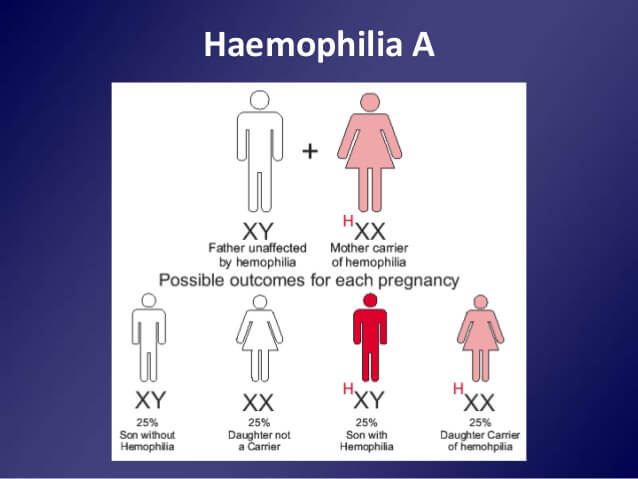Hemophilia A
Genetics and Transmission Patterns of Hemophilia A
 Graphic illustration courtesy of Slide Share Opens in new window
Graphic illustration courtesy of Slide Share Opens in new windowHemophia A is a classic X-linked recessive disorder Opens in new window in which the blood fails to clot normally because of a deficiency of factor VIII, a protein in the clotting cascade.
The hereditary nature of hemophilia and even its pattern of transmission have been recognized since ancient times, and the condition became known as the royal hemophilia because of its occurrence among descendants of Britain’s Queen Victoria, who was a carrier.
Xh represents the mutant factor VIII allele causing hemophilia A, and XH represents the normal allele.
If a hemophiliac mates with a normal female, all the sons receive their father’s Y chromosome and a maternal X and are unaffected, but all the daughters receive the paternal X chromosome with its hemophia allele and are obligate carriers:
| Affected Male by Normal Female: Xh/Y x XH/XH | |||
|---|---|---|---|
| XH | XH | ||
| Xh | XH/Xh | XH/Xh | Daughters: all carriers |
| Y | XH/Y | XH/Y | Sons: all unaffected |
Now assume that a daughter of the affected male mates with an unaffected male. Four genotypes are possible in the progeny, with equal probabilities:
| Normal Male by Carrier Female: XH/Y x XH/Xh | |||
|---|---|---|---|
| XH | Xh | ||
| XH | XH/XH | XH/Xh | Daughters: 1/2 normal, 1/2 carriers |
| Y | XH/Y | Xh/Y | Sons: 1/2 normal, 1/2 affected |
The hemophilia of an affected grandfather, which did not appear in any of his own children, has a 50% chance of appearing in the son of each of his daughters. It will not reappear among the descendants of his sons, however.
A daughter of a carrier has a 50% chance of being a carrier herself.
By chance, an X-linked recessive allele may be transmitted undetected through a series of female carriers before it is expressed in a male descendant.
See also:
- Adapted from Thompson & Thompson Genetics in Medicine E-Book By Robert L. Nussbaum, Roderick R. McInnes, Huntington F Willard

